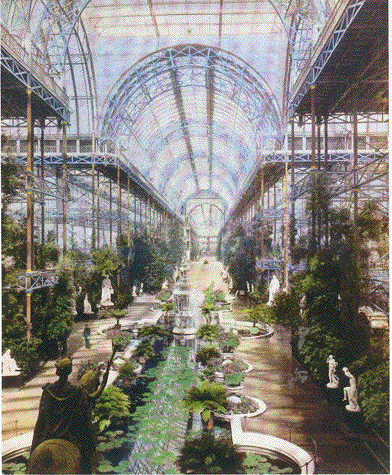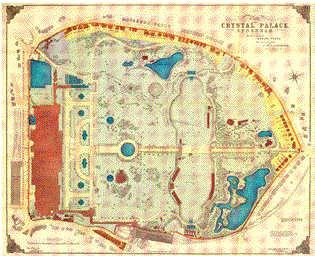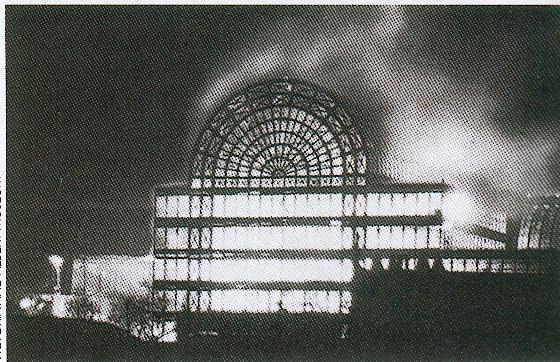(P.160) The Garden,
November 2006: RHS Lindley Library
Sale of the 20th
Century
|
One of the landmarks of Victorian
London, the Crystal Palace, was never a financial success,
and by 1911 was up for sale. BRENT ELLIOTT describes the
history of Sir Joseph Paxton's masterpiece in the light of a
recent Lindley Library acquisition. |
ONE OF THE Lindley
Library's most interesting recent acquisitions has been a
copy of the sale catalogue of the Crystal Palace and Crystal
Palace Park dating from 1911. A tall volume, 42 x 28 cm,
bound in brown linen wrappers with a scenic photograph on
the front and printed on linen paper, it contains an
itemised description of the structure, the park, and the
various leasehold properties around the park's perimeter -
including Rockhills, the former private garden of the
palace's creator Sir Joseph Paxton. It is illustrated with a
variety of photographs, some taken for the sale, others
historical photographs of the palace's construction. It
comes complete with a coloured plan, measuring 100 x 125
cm.
Many readers will not be
aware that the palace and its surroundings were once sold,
and as the future of the park continues to be a matter of
dispute, it seems a suitable time to review the history of
the site, and the sale.
Victorian
splendour
The Crystal Palace began
life as the building to house the Great Exhibition of 1851,
in Hyde Park. After the exhibition had ended, Sir Joseph
Paxton, it's designer, builder and impresario, acquired its
structural members and erected a bigger and better version
on Sydenham Hill in south London, which opened to the public
in 1854.
Inside the great glass
structure were displays of exotic plants, a huge collection
of sculptures, and areas devoted to different eras and
archeological sites. The park's exhibit of life-size
dinosaurs around the Lower Lake was a favourite with the
crowds (recently restored, these are one of the few original
features to remain) and there was a series of enormous
fountains.
Throughout the 19th
century, Crystal Palace Park remained the property of the
Crystal Palace Company. People paid an admission fee to
enter; notoriously, in 1859, Paxton opposed the introduction
of flowerbeds into the Royal Parks, presumably because he
feared that people would be less likely to pay the admission
fee if they could see flowers elsewhere. |
|

|
|
Harder
times
A serious fire destroyed
the north transept of the palace in 1866, and by the end of
the century, its fortunes were in decline. The park became
one of the pioneers in Britain of thrilling rides for the
public in an attempt to keep visitor figures up, but the
collapse into bankruptcy continued inexorably. Despite the
Festival of Empire which attracted hundreds of thousands of
people in 1911, King George V's coronation year, the affairs
of the company were wound up that year. The sale of the
palace and park, as a single lot, was entrusted to
auctioneers Knight, Frank and Rutley, to take place on 28
November.
The future of the palace
was debated heatedly in the press and elsewhere. The Prime
Ministers Of the Overseas Dominions wanted to use the
building as an 'Exhibition Empire Centre'. On 23 October, at
a public meeting, the Lord Mayor of London announced that it
should be acquired for the public, and a fundraising
campaign began. By the date of the auction, the necessary
amount had not been reached, but Lord Plymouth, the
President of the British Gardeners' Association, stepped in
and bought the palace and park for £230,000. He then
offered them to the nation for the same price.
Negotiations to find a
means of repaying Lord Plymouth soon got under way. London
County Council announced that it would offer £50,000,
and a Bill was rushed through Parliament to allow local
authorities to contribute money to the campaign. At the end
of June 1913 however, £90,000 still remained, so The
Times opened a fund and within 14 days, it had achieved the
total.
Then came the
retrenchments. Penge Council had promised £20,000, but
sent only £5,000; Camberwell Council was, even more
extreme, and reduced its contribution from £15,000 to
£600. Lord Plymouth accepted the situation with good
humour, despite his compensation being nearly £30,000
less than he had paid. But in October 1913, Crystal Palace
was finally secured for the nation, to be administered by
Bromley Council (now a London Borough). |

|

Neglect and
disaster
Since then, of course, the
history of the park and palace has been troubled. The palace
itself was destroyed by fire on 30 November 1936, and
decades of occasional suggestions have not yet resulted in
any choice for a replacement structure, nor even an agreed
use for it. |
After the Second World
war, a National Sports Centre was built in the south of the
park, cutting directly across the major axis of the design,
in 'a major intervention' in the landscape. Nearly a decade
ago, this building was listed Grade II* (the whole park was
already registered Grade II*).
The various authorities
cannot agree about the relative merits of the park and new
buildings. Plans for a redevelopment of the park, proposed
in the late 1990s, were initiated by Bromley Borough
Council, but only the first phase has been carried out - the
Heritage Lottery Fund declined to fund most of the
project.
The London Development
Agency, part of the Mayor's Office, recently appointed
landscape architect Latz and Partners to draw up a new
master plan for the site. The air is full of accusation,
complaints and proposals for discussions, much of it
online.
Personally, I would like
to see the sports centre demolished and the main outlines of
the park as laid out by Paxton restored. At present, the
future of one of Britain's most important parks, one of
London's largest green spaces, and one of the most
influential of public-garden designs remains uncertain.
|
Ed. Notes:
Park Ownership & control...
In 1951 Parliament passed the L.C.C. (Crystal Palace ) Act where the
responsibility for the Crystal Palace site was given to the London
County Council which was created in 1889. It was the first
metropolitan-wide form of general local government. The Greater
London Council (GLC), created in 1963, replaced the LCC and its first
members were elected in 1965. The GLC itself was abolished in 1986
and the services previously provided by the GLC were carved up
between central government, the boroughs and a new set of London-wide
bodies. The ownership of the Park then passed to the London Borough
of Bromley.
One of the main manifesto pledges
of the Labour Party in 1997 was a referendum on the re-introduction
of a democratically elected strategic authority for London, with a
directly elected Mayor and Assembly. The referendum, held in May
1998, endorsed the setting up of the Greater London Authority by a
three to one majority. The Greater London Authority Act received
Royal Assent at the end of 1999.
The London Development
Agency (LDA) which have an option to take over the running of
Crystal Palace Park, state that:
"We are the Mayor's agency
responsible for driving London's sustainable economic growth - it's
our job to ensure that London remains a global success story. To help
us deliver this we work with partners from industry, public and
voluntary sectors. As well as driving forward equality, health and
sustainability, our work is prioritised by four themes.
• Regenerating London
• Supporting People
• Encouraging Business
• Marketing London"
Under the "Regenerating London"
remit falls Crystal
Palace Park information from the LDA.
Future of the
Park...
The article states that "The air is
full of accusations and complaints...". However, the public
consultations show a remarkable degree of agreement with the concepts
proposed by Latz and Partners (the Master Planners). There are a few
points of dispute (inevitably) with some members of the public, but
for the first time since the great fire of 1936, the future for the
Park looks very promising.
Top of
page; Return
to Publications Index

14/3/07 Last Updated
14/3/07;25/02/09


